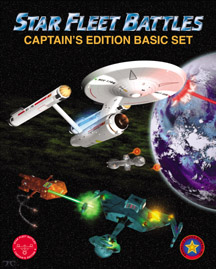Star Fleet Battles
| Publisher(s) | Amarillo Design Bureau |
|---|---|
| Publication date | 1979 |
| Genre(s) | Science fiction, board game |
| Age range | 10+ |
Star Fleet Battles (SFB) is a tactical board wargame set in an offshoot of the Star Trek setting called the Star Fleet Universe. Originally created in 1979 by Stephen V. Cole, it has had four major editions. The current edition is published by Amarillo Design Bureau as Star Fleet Battles, Captain's Edition. Star Fleet Battles was inducted into the Academy of Adventure Gaming, Arts, & Design Hall of Fame in 2005 where they stated that "Star Fleet Battles literally defined the genre of spaceship combat games in the early 1980s, and was the first game that combined a major license with 'high re-playability'." In his 2007 essay, Bruce Nesmith stated "No other game in hobby game history so completely captures the feel of ship-to-ship combat in space than Star Fleet Battles. The fact that it does so in the Star Fleet Universe is icing on the cake."
Star Fleet Battles is a ship-to-ship warfare simulation game, which uses cardboard counters to represent the ships, shuttles, seeking weapons, terrain, and information on a hexagonal map. It is not simply a game, but rather a detailed game system for two or more players (there are some solitaire scenarios). Typically, a player will have one ship in a game, though they can control an entire fleet, if they can keep track of the paperwork and options involved; multiple players can play as teams, with each team splitting up the work of running a squadron or fleet, or a 'free-for-all' fight can be run. Ships represented in the game are typically starships from such classic Star Trek powers as the Federation, Romulan Star Empire, Klingon Empire, or purely Star Fleet Universe creations such as the Hydran Kingdom or Interstellar Concordium.
The game system uses an impulse-based turn system, which is a departure from the traditional I-Go You-Go alternating system used by most wargames. A ship's speed determines how often and when it can move based on a 32 impulse movement chart. Generally, a unit only moves one hex at a time, making 32 the maximum 'speed' in the game. Similar systems are used in games such as Steve Jackson's Car Wars (which uses a 5 phase system) and is designed to more realistically simulate unit movement in an environment where the units can move a great distance in the time needed for non-movement functions (like weapons fire) to occur.
...
Wikipedia

